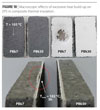IR-Reflecting Pigments

It is well known that modern IR-reflecting inorganic complex pigments not only impart super-durable colour shades to a surface, but enable coatings formulators to create products showing less interaction with solar radiation compared to using normal pigments, and therefore showing lower heat build-up.

|
| Figure 1 Click to enlarge |
The most well-known application is found in the area of coil coatings for facades and roofs (key word: cool roofs). The aim is to lower heat transfer into buildings, and as a result reduce energy consumption of air conditioners to cool down the interiors. A positive side effect – an enhanced lifetime of the coating due to reduced thermomechanical impact – has been observed. There are several programs available that define criteria and approve products for cool roof applications. Of these, the Energy Star and Cool Roof Rating Council of the United States are the best-known programs. Further programs are Green Globes (Canada and United States), LEED (United States) and one from the Singapore Environment Council. In Europe a similar program called Cool Roofs Europe has been started, and first products have been approved.

|
| Figure 2 Click to enlarge |
While the application of IR-reflecting pigments in coil coatings is accepted and subject to constant improvement, further applications are under development. This article will describe recent findings in car refinish paints and plasters for architectural thermal insulation systems, and present a new dark IR-reflecting pigment combining jetness with high solar reflection.
Influence of Solar Radiation on Pigments
Pigments interact with solar terrestrial radiation as described in Figure 1. Possible interactions are absorption (transmission), reflection and scattering. The interaction of colour pigments with the visible part of the electromag-netic spectrum (380 – 780 nm) is obvious in the form of our colour impression. Pigments can additionally interact with UV radiation (250 – 380 nm) and/or near-infrared (NIR 780 – 2500 nm) radiation. While the (detrimental) influence of UV radiation is well known (i.e., pigment fading), the interaction with the NIR radiation is its poor invisible cousin, although the integral energy of the NIR radiation accounts for approximately 50% of the total integral energy of solar radiation.

|
| Figure 3 Click to enlarge |
Heat Build-Up Effect of Different Pigments
The amount of total energy absorbed and emitted by a topcoat determines the heat build-up of a coated surface and results in a final surface temperature after reaching an equilibrium state. Coating pigmentation has the main influence on heat build-up performance. To achieve cool surfaces, the pigments need to reflect as much energy as possible. This reflection ability can be expressed as the Total Solar Reflectance value (100% = total reflection; 0 % = total absorption). Therefore, pigments with high TSR values show a high reflection combined with low heat build-up, and vice versa.
Pigments with the highest reflection ability are based on TiO2, while pigments with the lowest reflection are based on carbon black. If, from an aesthetic point of view, one prefers a dark colour instead of white, there is a choice of using dark inorganic complex pigments like P.Br. 29 (Chromium Iron Oxide) or P.Bk. 30 (Chrome Iron Nickel Black Spinel) as an IR-reflecting option. These pigments show higher TSR values compared to carbon black and are an excellent choice for grey colour shades; in mono-pigmented systems the TSR value is higher but the jetness is lower compared to carbon black.

|
| Figure 4 Click to enlarge |
Figures 2 and 3 illustrate TSR values of different pigmented topcoats with the corresponding heat build-up measurements.
Heat Build-Up Effect in a Multi-Layer-System
Although the use of black inorganic complex pigments with higher TSR values compared to carbon black is unlikely in full-shade car refinishes or OEM topcoats due to missing jetness, there is still some room for it in the total multi-layer set-up.
Conventionally, pigmented topcoats (high-performance organic pigments) are transparent or at least partially transparent to NIR radiation. As a consequence, the NIR radiation passes through the topcoat, and the IR reflectance ability of this multi-layer system is then determined by the behaviour of the next layer, in this case the primer. Primers are available in different colours, including light grey and dark grey, to support the colour of the topcoat (in case of scratches).

|
| Figure 5 Click to enlarge |
We modified a conventional white primer to a light grey and a dark grey primer, one modification with carbon black, the other with inorganic IR-reflecting black. Both modifications were tinted to the same colouristic values. Due to the better tinting strength of carbon black, a higher amount of inorganic black was necessary to achieve the similar colouristic result (Figure 4).
To check the influence of the primer pigmentation, we applied a blue and a red basecoat, including a clearcoat, onto the different primers to complete the full automotive refinish set-up (Figure 6).

|
| Figure 6 Click to enlarge |
In practice, a red basecoat is more likely to be combined with a white or light grey primer, while a blue basecoat is more likely to be combined with a light or dark grey primer, but not a white one.
The TSR values including the maximum temperatures of the heat build-up measurements of different multilayer combinations are listed in Table 1.

|
| Table 1 Click to enlarge |
In both cases (red and blue basecoat), the modification of the standard grey primers (containing carbon black) with inorganic IR-reflecting black pigments showed a significant effect for the multi-layer set-up in total performance.
Heat Build-Up Effect in a Composite Thermal Insulation System
Modern composite thermal insulation systems are used to keep the interior of buildings warm in winter and cold in summer to reduce energy consumption for heating and cooling. The insulation layer (commonly expanded polystyrene, EPS) largely reduces heat transport in any direction.

|
| Figure 7 Click to enlarge |
The darkness of the applied plaster on the EPS is limited, as it may suffer from thermal/thermomechanical stress, especially at the interface between the plaster and EPS layer. Therefore, thermal insulation systems are only offered to a certain point of luminosity values, indicating the darkness of the plaster.
Using IR-reflecting pigments, the heat build-up on the composite thermal insulation is reduced, with an expected positive impact on prevention of premature failure (Figure 7). As a consequence, using (dark) grey products with lower luminosity values is becoming a reality.
In a lab experiment, grey plasters with a 1/3, 1/9 and 1/25 standard depth (STD) were formulated using different pigment chemistry for each sample (P.Bk. 7, P.Bk. 11, P.Bk. 30 and P.Br. 29) and applied as a thermal insulation system.

|
| Figure 8 Click to enlarge |
In heat build-up tests for all standard depths, the systems with P.Bk.7 and P.Bk.11 showed a higher equilibrium temperature compared to the systems using P.Bk. 30 or P.Br. 29 (Figure 8).
Following these lab findings, outdoor exposure tests were performed. During an extraordinarily warm summer day (38 °C maximum temperature), samples coloured with PBk30 and PBk7 at 1/3 STD and P.Br. 29 and PBk7 at 1/9 STD were placed in the sun in Langelsheim, Germany (51.9°N, 10.3°E) facing south.

|
| Figure 9 Click to enlarge |
While the non-NIR reflecting samples reached surface temperatures of around 100 °C, the NIR-reflecting modified samples stayed approximately 10 °C cooler (see set-up of experiment in Figure 9 and summary of results in Table 2).

|
| Table 2 Click to enlarge |
Optimized IR-Reflecting Inorganic Black Pigment
While in full shade, the new pigment is more neutral compared to P.Br. 29 (Figure 12).
This behaviour can also be found in the 1:1 reduction (Figure 13). To achieve this colour shift to the more neutral side while staying with the higher TSR value, a lower tinting strength needs to be accepted.

|
| Figure 10 Click to enlarge |
Conclusion
Besides the well-known application of IR-reflecting pigments in coil coatings, possible benefits in two other areas have been found, and a new inorganic black pigment combining jetness and high TSR value was developed.
In multilayer systems, it is possible to formulate brilliant surfaces combining the brilliance of an NIR transparent topcoat (organic pigments) with the NIR reflection ability of the below primer layer (NIR-reflecting pigments instead of carbon black) to reduce heat build-up of the whole system. Such multilayer systems can be found in automotive OEM or refinishes, as well as in other industrial coatings applications. Although in the automotive industry research is currently focused on optimizing the window glazing due to its higher influence on heat build-up in the car interior, it can be expected that attention will turn back to the coating once the research for glazing is finished and the contribution of the car body/reflective coating gets higher again in relation.

|
| Figure 11 Click to enlarge |
Positive findings for lower heat build-up of thermal insulation systems using IR-reflecting black pigments instead of carbon black or black iron oxide have been reported for lab and outdoor tests. Detrimental effects on the dimension-al integrity of the expanded polystyrene insulation layer can be seen under real outdoor conditions, which can be minimized using IR-reflecting pigments. All in all, one can expect lower energy consumption for cooling building interiors as well as an enhanced lifetime of the thermal insulation system, reducing thermomechanical stress at the EPS/plaster interface.
A new inorganic black pigment has been developed combining jetness and a neutral colour shade in reductions with an extraordinary IR-reflecting ability bridging the gap between existing products.

|
| Figure 12 Click to enlarge |

|
| Figure 13 Click to enlarge |
Note: Cited TSR values have been determined in a 20% pigmentation in alkyd/melamine. The powder pigments themselves show even higher TSR values.
This paper was presented at the 2011 European Coatings Congress, Nuremberg, Germany.
Looking for a reprint of this article?
From high-res PDFs to custom plaques, order your copy today!





